We joked several times on the last episode of the podcast that this was going to be the year of the 4 at E3. We were all anticipating 2nds, 3rds, or 4ths of some series or another and that held up for the most part. One of the things that did get a lot of positive attention was the indie game Cuphead from Studio MDHR. MDHR describes Cuphead as a run and gun game in the style of 1930s cartoons, with handpainted backgrounds and original jazz scores. That all sounds awesome until you consider the nature of many of the (highly politicized) cartoons of the 1930s and 1940s.
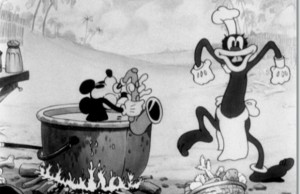
The 1930s and 40s saw us at the height of World War II in Europe and the Great Depression in the United States. Adolf Hitler was storming through Europe and persecuting those that he saw as inferior to the master race and trying to acquire as much land and power as he could. On U.S. soil the economic scene was horribly bleak. People were laid off in droves and forced onto the public dole. African Americans were often the first to be laid off and least likely to receive public assistance and if they did it was generally at a rate lower than their Caucasian counterparts. As in most times of economic hardship and un(der)employment, minorities and immigrants are often personally scapegoated. And this was something that became obvious not only in general society, but in popular media as well. Animated shorts were ridiculously guilty of this behavior and most notable in these cases were Walt Disney Studios. The 30s saw the production of a lot of Disney animated shorts that covered political and biological/hygiene issues that have since been buried or burned by the Disney corporation.
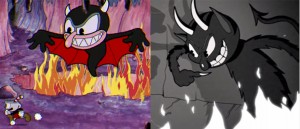
I say all of this to say that while I recognize that the cel shaded beauty and style of Cuphead is new to games and something to be appreciated, seeing the trailer for the game this week elicited a visceral reaction in me. It made me feel physically ill. I got queasy and my head swam a bit. It was one of those moments when you are sure that your blood pressure has shot up 20 or 30 points, a true WTF moment. I kept waiting for the other shoe to drop. I kept waiting for the next boss to be a thick-lipped, black-faced, spittle-dripping caricature of an African American man (probably holding aloft a terrified, screaming, blonde, Caucasian woman just to show what a threat he actually was). And looking back at the trailer for the game that was shown at last year’s E3 we see that the devil who is after the souls of our heroes (Cuphead and Mugman) is strangely reminiscent of caricature (NB that this year’s trailer devil was grayscale, so the color is unclear, with less pronounced lips).
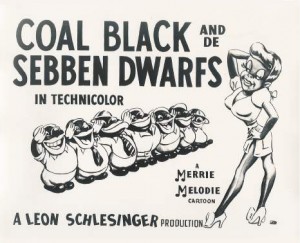
The jazzy score with the almost tribal undertones calls to mind not only the savage portrayal of men of the African diaspora, but also the savage sexualization of its women. We see this in the animated short Coal Black and de Sebben Dwarfs from Merrie Melodies of Bugs Bunny fame (which has its own issues with racism) This seems to line up well with all of the temptations that Cuphead and Mugman find themselves faced with gambling, speakeasies, liquor, and sirens, all things reminiscent of African American culture and the Harlem Renaissance. And while the siren that we see at the end of the trailer is not African American, she is there to serve as a obstruction to reaching their goal.
While Studio MDHR was founded by two brothers from Canada, the development team of the game itself seems to be fairly diverse, hailing from both Canada and the U.S. With this kind of diversity one can really ask why no one questioned the original choice to go with an animation style that is so racially loaded (or how it made it past review at Microsoft). While you could question whether or not the team was aware of the history of the animation style that they use in Cuphead (not really because watching any of the films in question makes it apparent) it is also very telling that the devil character in the game was changed from one showing at E3 to the next. That signals that this depiction might have just been brought to their attention sometime during last year’s E3. And honestly, it’s hard to tell tell from a series of trailers, but what I am speaking from is my own reaction to the piece.
My life, my experiences, and the body that I live in makes Cuphead and its artistic style problematic to me because of all that it has come to mean in the last 85 years or so and that’s something that I just can’t let go of. Does this mean that anything that is problematic should never be used in games or other entertainment media? We’ve heard that question in other contexts before. Should rape ever be used as a plot device? Abuse of any kind? And the answer remains the same. If it is done well and with proper attention being paid to the narrative. And Cuphead just isn’t the place for it in my mind. The game threatens to draw upon racist caricatures to inform the narrative and give players a series of racism infused bosses and obstructions to justice to properly hate. Perpetuating the stereotype and, in some cases, feeding the racism that is foundational to the art style itself. As for me, I’m going to skip Cuphead (as innovative as everyone claims) because it just hits too damned close to home.


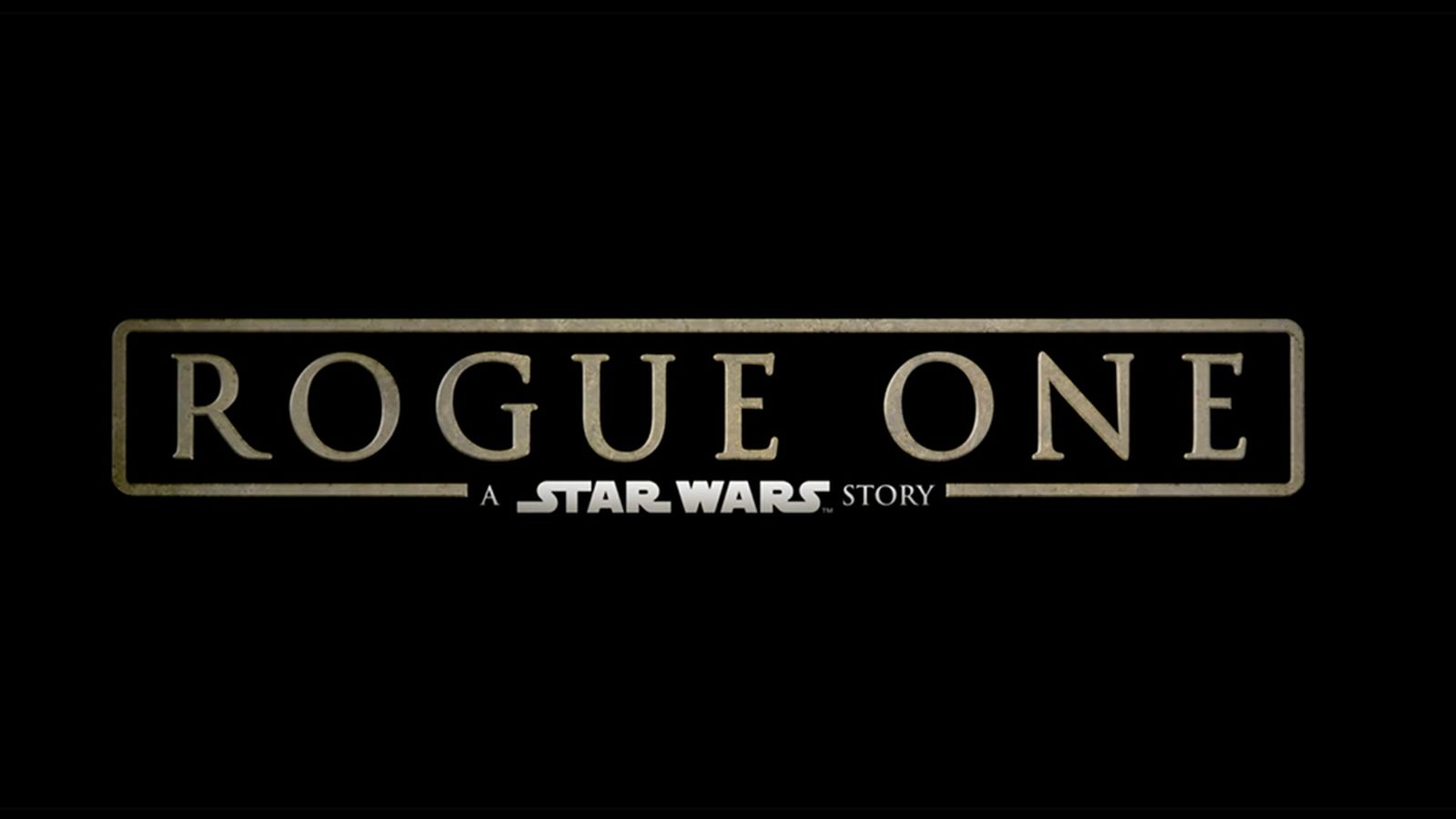
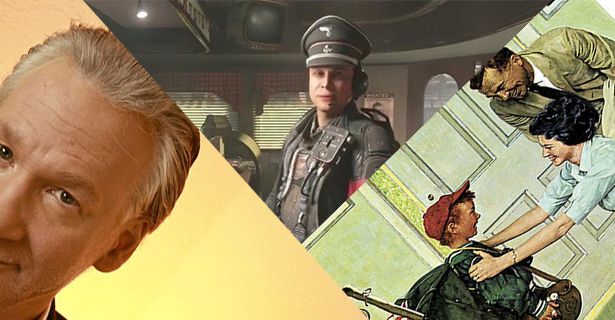

20 thoughts on “Pickaninnies and Pixels: On Race, Racism, and Cuphead at E3”
Soulja Boy seems to have no problems with it:
https://www.youtube.com/watch?v=3ySHzrtM6ZI
Oh dang, I forgot that Soulja Boy is the arbiter of all possible racist issues and associations.
Thanks for the article. I won’t lie, this game did look very interesting to me. Shining some light on some of the history made me reflect on considering whether if I wanted this in my game library in the future.
Very good read.
Really interesting perspective here. I know the early reviews on the trailer are overwhelming calling it “beautiful” and not really tackling this issue at all. I’m curious to see if the game or the developers will interrogate it.
I think there’s a lot of good potential there for a deep discussion about that and I would like to see them comment on it. There’s a reason they chose this — are they trying to resurrect an art style with so many poor connotations to trump the past? That’s an intriguing angle. Are they just saying, look, forget the history, here it is without those elements? Or will we see some of those elements in this game? Whatever happens, I’m very fascinated in watching this develop.
So, while I respect that it unsettled you and it’s by all means your choice not to play or buy the game… how do you interact with any media at all, given that all of it has the potential threat of racist content if handled poorly?
Do we need a National Advisory board?
Boy, you really took that and ran with it, huh? I don’t see anything in Sam’s piece that indicates all media or all associations make things off-limits. She referred to this specific artistic choice and the feelings it inspired in her. I mean, not to be flip, but #notallpotentiallyracistassociations, you know? Everyone has their lines and limits; this is one of hers.
Yes, shining some light on a handful of racist cartoons from the era might make one think that every cartoon from that era is racist. Fortunately that’s not the case, and I don’t think that it’s fair to judge this game based on thinking that way, especially when it’s compared beside possibly one of the most racist of all early cartoons, Coal Black. This game isn’t Coal Black, nor is it ‘Bugs Bunny Nips the Nips’, ‘Jungle Jitters’, or any of the other similar cartoons, nor are they remaking ‘The Birth of a Nation’. It’s evocative of an era of animation that has been lost since the fifties when the frame rates dropped by half, eventually leading the way to soulless digital animation.
Musically, it reminds me of this:
https://www.youtube.com/watch?v=2IQNPlnc9c0
which to my ear doesn’t call to mind savage African men or the sexualization of women, but actually suggests, get this, jazz music. Anyone who has done any research of music history would know that early jazz evolved when the slaves in Congo Square played their traditional African music on European instruments. Does that make jazz music itself ‘racist’? Hardly. I could go on but sadly I’m at work. I feel the authors of this article are really grasping at straws, and Chijiru, it would be unfortunate if you made your decision about this game based on a very, very one sided argument.
No, it isn’t any of those things. Sam didn’t say it was. Sam said it reminded her of that and she made a choice. You can make a choice. I’m not sure why the making of a choice and a statement inspires such a reaction. How are you affected when someone else says, “hey, that’s not for me?”
It baffles me how many logical hoops someone had to jump through to paint a videogame with zero racial or political undertones as being racist simply for having the same animation style of old cartoons.
I guess I’m not going to drink Coca-Cola products anymore because Fanta was founded in Nazi Germany? Wouldn’t want to be a racist!
Amazing the logical leaps people make to assume that I was calling anyone racist. I was simply looking at the game and my gut reaction to it. Actually reading the post reveals that I clearly say
And I also end by saying that for me the game was a no buy. I really want other people to buy and play the games that they enjoy as it is their right. I hope that you buy and enjoy the game…and your Coke.
Oh yes, we’re the ones who took this and ran with it. Except for…
‘I kept waiting for the other shoe to drop. I kept waiting for the next boss to be a thick-lipped, black-faced, spittle-dripping caricature of an African American man (probably holding aloft a terrified, screaming, blonde, Caucasian woman just to show what a threat he actually was).’
‘The jazzy score with the almost tribal undertones calls to mind not only the savage portrayal of men of the African diaspora, but also the savage sexualization of its women.’
‘This seems to line up well with all of the temptations that Cuphead and Mugman find themselves faced with gambling, speakeasies, liquor, and sirens, all things reminiscent of African American culture and the Harlem Renaissance. And while the siren that we see at the end of the trailer is not African American, she is there to serve as a obstruction to reaching their goal.’
‘The game threatens to draw upon racist caricatures to inform the narrative and give players a series of racism infused bosses and obstructions to justice to properly hate. Perpetuating the stereotype and, in some cases, feeding the racism that is foundational to the art style itself.’
Samantha Blackmon, I do respect your opinion and what you feel when you watch this trailer, but you paint a large swath of art and history with the same brush, despite your careful wording which allows you to say ‘this is just my opinion’. Regardless of what yourself and Alisha say to the contrary, this article screams ‘Cuphead is Racist’, and your comparisons are quite clearly meant to elicit that same response in the reader, all without actually offering a balanced opinion. Why not wait until the game is actually released to pass judgement?
I’m not gonna speak for Sam, but I do want to address your last question. Are you implying that one should not develop some opinion based on a trailer or early footage? Is that not what trailers are for? Is it only troubling to you because it’s not your opinion?
There seems to be an implication that the game is likely going to contain racist imagery based on the very little info presented. Yet again, I use Sam’s quote:
‘The game threatens to draw upon racist caricatures to inform the narrative and give players a series of racism infused bosses and obstructions to justice to properly hate.’
The game does not threaten this, the trailer does not threaten this. It is you who threaten to deduce this.
I’m not troubled by my opinion, since I am open minded enough to not assume things, like that the devil is a racist blackface caricature, that the devil in this game is inherently bad, that this game is just another case of white oppression etc etc. I’m only troubled by opinions that condemn a project prematurely based solely on ‘what might be’. If one thinks that watching a short trailer gives them an insight into every facet of the game/movie/etc, then I congratulate them on their extra sensory insight.
The problem with this article, whether intentional or not, is that is doesn’t come across as ‘Is Cuphead Racist’, but more as ‘Cuphead is Racist’. It sounds and reads like an attack and not a level headed editorial.
If this is some kind of vague calling card for a boycott on Cuphead, I’m going to cackle like a near-dead ICU patient.
No, not a call for a boycott at all. Simply me sharing my reaction to the piece. Clearly you don’t know the work that we do here or you would know that we say at every turn, play what you feel comfortable playing. Censorship is not my thing, critique is.
It’s not a very big logical leap Samantha. Your headline is “On Race, Racism, and Cuphead at E3”. Are we supposed to take from that that you are discussing race, racism, and on an unrelated note – cuphead at E3?
You probably wouldn’t like it if someone wrote “On Lies, Theft, and Samantha Blackmon”.
You are supposed to take from it that I am doing just what I am doing. Discussing race, racism, and the game. Race, racism, and Cuphead is much different that Race and Racism in Cuphead. And as I said before, simply taking the time to read the post would clear up any ambiguity.
Uh, the game’s artistic style is reminiscent of a racist style of cartoon. The coloring, line, and shading are all indicative of the stuff Sam is mentioning. You would have to be fucking blind to not make that connection. Stop trying to make the argument about nazis and coke and that there are other cartoons from that era that aren’t racist. That’s not the point. This style is harkening back to the style of racist cartoons in the 30s. Period. Not that all cartoons are racist, not that all games that have any problematic stuff should be banned, none of that. Her point is that the connection between the animation style of this game and racist cartoons made her feel ill and is problematic.
Please note that yes, there are a number of comments that I have not and will not approve. We are always willing to engage even when people has opinions that differ from our own, that’s the nature of critique and conversation. But, when you come here strictly for the purpose of trolling, are disrespectful, or seek to shut down all dialogue you won’t be allowed to engage at all. Not in our space.
Once again for the cheap seats:
1. Check out the about page, this is not my job. I don’t get paid for this. My job supports it.
2. I am not calling for the boycott or cancellation of this game. The post was about my reaction to the trailer and the memories that are elicited from it. Says that clearly in the post.
3. I’m not calling the game or all cartoons made in the 1930s and 40s racist. I mentioned racist elements in some cartoons.
4. I’m amused that folks are so pissed off that I give my opinion of the trailer (not of the game) when no one has complained about folks saying what a great game it’s going to be based on the same trailer.
5. By definition, if you say something threatens to be or do something that means that there is a possibility that there would be (but also a possibility that it would not).
6. All POC do not have the same experience so dismissing my opinions because you are also a POC is not a valid argument. Sorry.
7. The history of animated shorts during the 30s and 40s is not something new to me. I’ve been researching them for longer than many of our readers (and writers) have been alive.
And most importantly,
8. I’m not a millennial, sorry. Far too old for that. But I’ll take it as a compliment that some folks think that I may be. It means that my “Get Off My Lawn” vibe is not as strong as I thought.